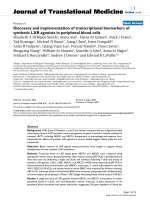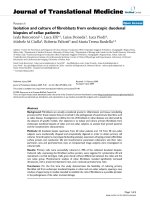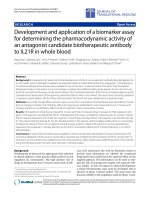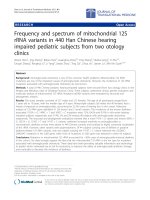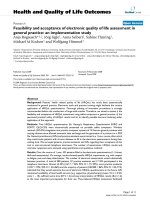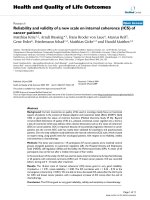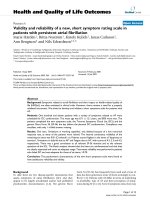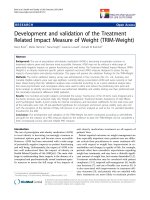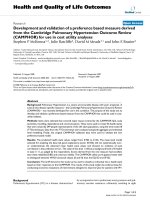báo cáo hóa học:" Dimensions and correlates of quality of life according to frailty status: a cross-sectional study on community-dwelling older adults referred to an outpatient geriatric service in Italy" ppt
Bạn đang xem bản rút gọn của tài liệu. Xem và tải ngay bản đầy đủ của tài liệu tại đây (695 KB, 10 trang )
Bilotta et al. Health and Quality of Life Outcomes 2010, 8:56
/>Open Access
RESEARCH
© 2010 Bilotta et al; licensee BioMed Central Ltd. This is an Open Access article distributed under the terms of the Creative Commons
Attribution License ( which permits unrestricted use, distribution, and reproduction in
any medium, provided the original work is properly cited.
Research
Dimensions and correlates of quality of life
according to frailty status: a cross-sectional study
on community-dwelling older adults referred to an
outpatient geriatric service in Italy
Claudio Bilotta*
1
, Ann Bowling
2
, Alessandra Casè
1
, Paola Nicolini
1
, Sabrina Mauri
1
, Manuela Castelli
1
and
Carlo Vergani
1
Abstract
Background: There is a lack of knowledge concerning the relationship between two closely-linked multidimensional
variables: frailty and quality of life (QOL). The aim of this study was to investigate dimensions and correlates of QOL
associated with frailty status among community-dwelling older outpatients.
Methods: We conducted a cross-sectional survey of 239 community-dwelling outpatients aged 65+ (mean age 81.5
years) consecutively referred to a geriatric medicine clinic in Italy between June and November 2009. Participants
underwent a comprehensive geriatric assessment, including assessment of their frailty status according to the Study of
Osteoporotic Fractures (SOF) criteria, and QOL, which was evaluated by using the Older People's QOL (OPQOL)
questionnaire. One-way ANOVA and chi-squared tests were used to find correlates of frailty, including QOL dimensions,
after stratification of participants in the "robust" (n = 72), "pre-frail" (n = 89) and "frail" (n = 78) groups. Multiple linear
regression analyses were performed to find correlates of QOL in the overall sample and among "frail" and "robust"
participants.
Results: A negative trend of QOL with frailty status was found for almost all dimensions of QOL (health, independence,
home and neighbourhood, psychological and emotional well-being, and leisure, activities and religion) except for
social relationships and participation and financial circumstances. Independent correlates of a poor QOL in the total
sample were "reduced energy level" (SOF criterion for frailty), depressive status, dependence in transferring and
bathing abilities and money management (adjusted R squared 0.39); among "frail" participants the associations were
with depressive status and younger age, and among "robust" participants the association was with lower body mass
index.
Conclusions: Five out of seven dimensions of QOL were negatively affected by frailty, but only one SOF criterion for
frailty was independently related to QOL, after correction for age, functional status and depression. A more advanced
age as well as a better affective status were correlates of a better QOL among frail elders. Interventions targeting the
QOL in frail community-dwelling older outpatients should consider as outcomes, not only health-related QOL, but also
other domains of the QOL.
Background
Frailty has been defined as a state of increased vulnerabil-
ity to stressors that results from decreased physiological
reserves, and even dysregulation, of multiple physiologic
systems [1]. Whether it be considered a state variable
resulting from the accumulation of deficits [2] or a spe-
cific clinical phenotype, separate but partly overlapping
with the concepts of chronic disease and disability [1,3],
frailty is a well-known risk factor for adverse events such
* Correspondence:
1
Department of Internal Medicine, Geriatric Medicine Unit, Fondazione IRCCS
Cà Granda Ospedale Maggiore Policlinico, University of Milan, Milan, Italy
Full list of author information is available at the end of the article
Bilotta et al. Health and Quality of Life Outcomes 2010, 8:56
/>Page 2 of 10
as functional decline, hospitalisation and death [1-3] and
it has recently been shown to represent the main cause of
death among community-dwelling older people [4].
Moreover, frailty has been associated with a significant
impairment in the quality of life (QOL) [1-3]. QOL has
been defined as an individual's perception of their posi-
tion in life in the context of the culture and value system
in which they live and in relation to their goals, expecta-
tions, standards and concerns [5]. It is a multidimensional
variable and its correlates may be different according to
the specific contexts [6,7].
Only very few randomised controlled trials targeting
frail older people have considered QOL among out-
comes, and QOL has seldom been shown to be improved
[8,9]. Furthermore, many studies on frailty have taken
into account the self-perceived health status or the
health-related QOL and have not assessed QOL in gen-
eral [3,10-14]. Masel and colleagues recently reported
that in older Mexican Americans being pre-frail or frail
was associated with worse scores on all physical and
mental health-related quality of life scales than being
non-frail [13]. However, they were unable to examine
possible associations between frailty status and the social
context of QOL because the QOL measures used in their
research were health-focused.
More generally, it has been proposed that the onset of
frailty is associated with an identity crisis, the so-called
frailty identity crisis, a psychological syndrome that may
accompany the transition from robustness to the "next to
last" stage of life [15]. The psychological challenges stem-
ming from the development of frailty such as regrets, sad-
ness and depression can complicate physical frailty itself
and have received little attention in literature so far;
therefore, the need for studies on the independent corre-
lates and outcomes of the frailty identity crisis, including
QOL, has been recently highlighted [15].
Thus little is still known on the relationship between
frailty status and the different aspects of QOL in general
as well as on the interventions to improve QOL in frail
elders. The aims of this study were i) to find out which
dimensions of QOL are associated with frailty status
among community-dwelling older outpatients referred to
a geriatric medicine clinic in Italy, and ii) to investigate
independent correlates of QOL both in the overall sample
and in two specific subgroups, the frail and robust older
adults.
Methods
Design, setting and participants
This observational cross-sectional study has considered
302 community-dwelling outpatients aged 65+ who con-
secutively underwent a first geriatric visit at the Fondazi-
one Cà Granda Ospedale Maggiore Policlinico in Milan,
Italy, from June 15 to November 15 2009. All subjects had
been referred to this outpatient clinic by their general
practitioners. All patients underwent a comprehensive
geriatric assessment (CGA), which constitutes a standard
procedure of the visit and includes both an evaluation of
cognitive status by means of the Mini-Mental State
Examination (MMSE) [16] and an evaluation of frailty
status according to the recent Study of Osteoporotic
Fractures (SOF) criteria [10,17]. Study participants were
asked to fill in a general questionnaire on the QOL, called
Older People's Quality of Life (OPQOL) [18-20], which is
described below. The compilation of the questionnaire
was carried out in the waiting room, before the visit; it
was done by the patient completely on his/her own or
with the help of a non-health volunteer who had been
trained for the task, i.e. had been instructed to read out
the questions, explain them when required and/or note
down the answers chosen by the participant. If an infor-
mal caregiver accompanied the patient he/she was invited
to refrain from influencing the choice of the answer,
which had to be made by the older participant him/her-
self.
In order to ensure that the answers to the OPQOL
would be reliable we excluded from the study subjects
with severe cognitive impairment, indicated by a MMSE
score < 11 out of 30 (n = 20) [21-23]. We also excluded
from the study subjects who were unable to fill in the
questionnaire properly because they did not understand
all the questions (n = 26), those who refused to answer
the questionnaire (n = 12) and those who did not give
their written informed consent to the study (n = 5). The
study therefore enrolled a sample of 239 community-
dwelling older outpatients.
Comprehensive geriatric assessment
The CGA included the main demographic, social and
environmental characteristics of the participants, the
occurrence of specific life events in the year prior to the
visit, functional and physical status, comorbidity and
frailty status. It was carried out during the visit by a
multi-professional team which included a geriatrician
and a professional nurse. The demographic characteris-
tics considered were: age, gender, years of schooling and
civil status. A number of social and environmental char-
acteristics were also taken into account: living alone,
home ownership status, home surface area, yearly family
income, main characteristics of the carers, both informal
and formal (if present). We also considered the occur-
rence of specific life events in the year prior to the visit:
bereavement of partner or other family member, falls,
admittance to the emergency department, hospitalisa-
tion, diseases with a severe prognosis (such as pneumo-
Bilotta et al. Health and Quality of Life Outcomes 2010, 8:56
/>Page 3 of 10
nia, myocardial infarction, stroke, hypokinetic syndrome
due to a bone fracture) and being victim of crime.
Functional status was assessed by means of the scales
for the Basic Activities of Daily Living (BADL) [24] and
the Instrumental Activities of Daily Living (IADL) [25],
cognitive status by means of the MMSE scale with score
correction for age and education [16], severity of demen-
tia by means of the Clinical Dementia Rating (CDR) scale
[26], emotional status by means of the 30-item Geriatric
Depression Scale (GDS) [27] in subjects without demen-
tia and with mild dementia (i.e. CDR score below 2 out of
5) and the Cornell scale for depression in dementia in the
remaining subjects [28]. Comorbidity was assessed by
means of the Cumulative Illness Rating Scale morbidity
(CIRS-m) scale [29] and by considering any osteomuscu-
lar disease - given the correlation between this variable
and the health-related QOL [13] - and the number of
drugs taken daily. The diagnoses of dementia and depres-
sion were made according to the criteria of the Diagnostic
and Statistical Manual of Mental Disorders fourth edition
text revision (DSM-IV-TR) [30]. Weight, height and body
mass index (BMI) (the weight in kilograms divided by the
square of the height in metres) of participants were all
measured during the visit with patients wearing light
clothing, without shoes.
Frailty status and QOL assessment
The frailty status of the participants was evaluated
according to the recent Study of Osteoporotic Fractures
(SOF) criteria, which are regarded to be just as effective
as the frailty criteria of Fried et al. [3] in predicting
adverse health outcomes but are easier to apply
[10,17,31]. The SOF index is composed of three items: 1)
intentional or unintentional weight loss > 5% in the past
year, 2) inability to rise from a chair five consecutive
times without using the arms, 3) self-perceived reduced
energy level as described by a negative answer to the
question "do you feel full of energy?". Subjects are consid-
ered "frail" if at least two of the three criteria are fulfilled,
"pre-frail" if only one criterion is present and "robust" if
none of the criteria are present.
QOL of the participants was evaluated by means of the
OPQOL questionnaire, which has been recently validated
on a community-dwelling older population in England
[18-20]. It consists of 35 statements with the participant
being asked to indicate the extent to which he/she agrees
with every single statement by choosing one of five possi-
ble options among "strongly disagree", "disagree", "neither
agree nor disagree", "agree" and "strongly agree". Each of
the five possible answers is given a score of 1 to 5 so that
higher scores indicate a better QOL. Thus the total score
ranges from 35 (the worst possible QOL) to 175 (the best
possible QOL). The 35 statements of the questionnaire
consider the following aspects of QOL: life overall (score
range 4-20), health (4-20), social relationships and partic-
ipation (5-25), independence, control over life and free-
dom (4-20), home and neighbourhood (4-20),
psychological and emotional well-being (4-20), financial
circumstances (4-20), leisure, activities and religion (6-
30).
Statistical analyses and sample size calculations
In order to find out which dimensions of QOL were asso-
ciated with the frailty syndrome participants were strati-
fied into three groups, namely the "robust", "pre-frail" and
"frail" groups according to the SOF criteria. The one-way
ANOVA for metric variables with a normal distribution
and Pearson's chi-squared test or Fisher's exact test for
nominal variables were used in order to verify the null-
hypothesis that the different dimensions of QOL as
described by OPQOL sub-scores, as well as the charac-
teristics of participants including the OPQOL total score,
were similar across the three above-mentioned groups.
In order to investigate the characteristics associated
with QOL in the sample overall as well as in the "frail" and
in the "robust" groups, participants were stratified into
three groups according to the lowest, intermediate and
highest tertiles of the OPQOL total score. The one-way
ANOVA for metric variables with a normal distribution
and Pearson's chi-squared test or Fisher's exact test for
nominal variables were also used in order to verify the
null-hypothesis that the characteristics of the older par-
ticipants were similar in the three QOL-related groups. A
P-value less than or equal to 0.05 was assumed to indicate
statistical significance.
As far as multivariate analyses in the total sample were
concerned, two models of linear regression analysis were
developed, both assuming the OPQOL total score as the
dependent variable. All the variables which were signifi-
cantly associated with QOL in a linear way at the univari-
ate analyses previously described, were included as
covariates in the first multivariate model. We chose to
include in the model the nominal variable "depression"
and not also the "GDS score" because the latter was not
available for all participants as previously explained. The
second multivariate model considered the variables sig-
nificantly associated with the OPQOL total score in the
first model and included the three SOF criteria instead of
the nominal variable "frailty", the six single BADLs
instead of the BADL score and the eight single IADLs
instead of the IADL score: all these nominal variables
were found to be significantly related to the OPQOL
score in a linear way at univariate analysis (data not
shown). Both models were adjusted for the age of the par-
ticipants. In order to justify the entry of the variables in
the multivariate models multicollinearity was assessed by
Bilotta et al. Health and Quality of Life Outcomes 2010, 8:56
/>Page 4 of 10
examining the tolerance values, which resulted to be rea-
sonably high (low values close to zero indicating multiple
correlation with other entered variables) [32]. Secondary
analyses - both univariate and multivariate - were per-
formed specifically on the "frail" and "robust" groups
according to these same selection criteria. Statistical
analyses were performed by means of SPSS 14.0 for Win-
dows.
As far as sample size calculations were concerned, we
assumed the mean (SD) OPQOL total score among non
frail older outpatients to be similar to that found by Bowl-
ing [19] in a community-dwelling population aged 65+
[i.e. 134 (14) out of 175], in which the prevalence of frail
subjects according to the SOF criteria is expected to be
very low, below 5% [31]. Since our sample consisted of
outpatients the expected prevalence of frailty was much
higher [33], estimated at more than 30%. It was therefore
calculated that with a sample of about 240 participants
the study would have obtained an almost 80% statistical
power at 5% alpha level to detect a difference in the
OPQOL total score of at least 5 points out of 175 in frail
subjects compared to the rest of the sample.
Results
The sample was composed of 239 older people living in
the community, mainly females (n = 164), with an average
(SD) age of 81.5 (6.3) years. The participants lived alone
in 107 cases (45%) and had at least one carer, informal
and/or formal, in 145 cases (61%). They were affected by
an average of 4.3 (SD 1.9) chronic diseases and consumed
an average of 5.4 (SD 2.9) drugs a day. They suffered from
dementia and depression in 62 (26%) (46 women and 16
men, mean age 81.8 years) and 123 (52%) (94 women and
29 men, mean age 81.6 years) cases respectively.
Sixty-one participants (26%) required the help of the
non-health volunteer to fill in the OPQOL questionnaire,
half of them (31 out of 61) were suffering from dementia.
For all participants it was possibile to define frailty status
according to the SOF criteria.
Dimensions of QOL associated with frailty status
According to the SOF criteria 72 participants (30%) were
"robust", 89 (37%) were "pre frail" and 78 (33%) were
"frail". Besides the OPQOL total score, a number of char-
acteristics of the older subjects were found to be associ-
ated with frailty (Table 1 and Additional file 1). If we
consider the different aspects of the QOL, almost all
dimensions of QOL as described by OPQOL sub-scores
were inversely correlated to frailty (i.e. "health", "indepen-
dence", "home and neighbourhood", "psychological and
emotional well-being", and "leisure, activities and reli-
gion") except "social relationships and participation" and
"financial circumstances" (Table 1 and Additional file 1).
Correlates of QOL according to frailty status
In the total sample several variables, including frailty,
were significantly associated with a worse QOL at univar-
iate analyses (Table 2 and Additional file 2). Among all
these variables, at multivariate regression analysis (model
1 in Table 3), those associated with a worse QOL were
being frail, dependence in BADLs and IADLs and depres-
sion. However, including in the model the three SOF cri-
teria for frailty, the six specific BADLs and the eight
specific IADL items (model 2 in Table 3), besides depres-
sion four variables were independently associated with
QOL (adjusted R squared 0.39): only one of the SOF cri-
teria for frailty - the "reduced energy level" criterion - and
dependence in two BADLs - transferring and bathing -
and in a specific IADL - management of money
The secondary analyses showed that among "frail" par-
ticipants both a better emotional status and a more
advanced age were associated with a better QOL (Table 2
and Table 4), whereas among "robust" participants only
the BMI was directly associated with QOL (Table 2 and
Table 4).
Discussion
In this cross-sectional study of the complex relationship
between frailty status and generic QOL in a sample of
community-dwelling older outpatients without severe
dementia, we used two recently validated assessment
tools: the SOF criteria for frailty status, which were dem-
onstrated to be applicable to the whole sample, and the
OPQOL. The OPQOL has excellent applicability to cog-
nitively normal subjects [19], and was shown here to be
applicable to people suffering from mild to moderate
dementia. The CGA we used included several important
social factors determining health in older age, such as
recent life events, housing, financial status and social iso-
lation [34]. The high prevalence of frailty, dementia and
depression that we found in the sample could be
accounted for by the specific setting of the study which
involved geriatric outpatients. This hypothesis is sup-
ported by the fact that in another recent study on older
outpatients with a disability referred to the same geriatric
service the prevalence of depressive disorders was found
to be even greater (i.e. over 70%) [35].
Dimensions of QOL associated with frailty status
As far as the correlates of frailty were concerned, consis-
tent with other studies we found that frail subjects
reported a worse overall QOL than pre-frail and non-frail
subjects [3,8,10-14,36]. Moreover, according to the find-
ings of this study as many as five of the seven dimensions
of QOL that we investigated were found to be impaired in
frail older participants. This suggests that interventions
targeting QOL in frail community-dwelling older outpa-
Bilotta et al. Health and Quality of Life Outcomes 2010, 8:56
/>Page 5 of 10
Table 1: Characteristics of participants by frailty status (n = 239).
Variables Robust
(n = 72)
Pre-Frail
(n = 89)
Frail
(n = 78)
Mean (SD) or % (n) Mean (SD) or % (n)Mean (SD) or % (n)
Age (years) 79.4 (6.2) 81.5 (6.2) 83.5 (5.8)
Civil status
Unmarried 5 (4) 21 (19) 9 (7)
Married 49 (35) 24 (21) 31 (24)
Divorced 4 (3) 6 (5) 4 (3)
Widowed 42 (30) 49 (44) 57 (44)
No caregiver 49 (35) 46 (41) 23 (18)
Informal Caregiver: Spouse 26 (19) 9 (8) 17 (13)
Informal Caregiver: Child 19 (14) 36 (32) 41 (32)
Paid personal assistance 10 (7) 14 (12) 24 (19)
Living alone 36 (26) 55 (49) 41 (32)
Any hospital admission in the past year 6 (4) 16 (14) 24 (19)
BADL score
a
5.1 (1.4) 4.7 (1.5) 3.3 (1.8)
IADL score
b
5.3 (2.8) 4.8 (2.8) 2.8 (2.2)
GDS score
c
7.4 (4.8) 12.2 (7.6) 13.3 (7.1)
CIRS m score
d
3.7 (1.6) 4.2 (1.7) 5.0 (2.0)
Any osteomuscular disease 39 (28) 57 (51) 77 (60)
Depression 31 (22) 58 (51) 64 (50)
Number of drugs taken 4.4 (2.7) 5.4 (2.8) 6.4 (2.9)
OPQOL total score
e
125.9 (13.2) 115.6 (13.9) 107.4 (12.6)
Life overall 14.9 (2.4) 13.0 (2.8) 12.0 (3.2)
Health 12.9 (2.6) 10.5 (2.8) 8.2 (2.8)
Social relationships and participation 17.8 (3.2) 17.2 (3.3) 17.2 (3.5)
Independence, control over life,
freedom
14.2 (2.9) 12.4 (3) 10.7 (2.8)
Home and neighbourhood 16.7 (2.2) 15.9 (2.4) 15.3 (1.8)
Psychological and emotional well-
being
15.1 (2.5) 13.7 (2.9) 12.6 (2.6)
Financial circumstances 13.5 (3.2) 13.1 (3.0) 12.8 (3.3)
Leisure, activities and religion 20.8 (3.5) 19.7 (3.1) 18.7 (2.5)
Notes: Variables in bold are significant at p < 0.05; Besides quality of life assessment, reported in this table are only the variables significantly
related to frailty status; All the variables and their p-values are reported in the Additional file 1.
a) Basic Activities of Daily Living. Score range 0 - 6. Higher scores indicate greater independence.
b) Instrumental Activities of Daily Living. Score range 0-8. Higher scores indicate greater independence.
c) Thirty item - Geriatric Depression Scale. Score range 0 - 30. Higher scores indicate worse depressive status. This variable was analysed only
in participants without dementia or suffering from mild dementia: 61 subjects belonging to the "robust" group, 77 subjects to the "pre-frail"
group and 65 subjects to the "frail" group.
d) Cumulative Illness Rating Scale morbidity. Scores 0-13. Higher scores indicate higher morbidity.
e) Older People's Quality of Life (OPQOL) questionnaire. Total score range 35-175. Higher scores indicate better quality of life.
Bilotta et al. Health and Quality of Life Outcomes 2010, 8:56
/>Page 6 of 10
tients should consider as outcomes, not only health-
related QOL, but also other domains of QOL, such as
functional independence, psychological well-being, home
and neighbourhood, leisure activities and religion. Only
the QOL domains of "social relationships and participa-
tion" and "financial circumstances" were not significantly
different among the three "frailty status" groups.
These findings are consistent with i) the objective vari-
ables which were associated with frailty, such as func-
tional dependence, depression and comorbidity, already
highlighted by recent studies [3,10-12,37], ii) the fact that
"frail" participants had higher levels of formal and infor-
mal personal support, and iii) the fact that living and
financial conditions were similar along the three groups.
As far as the latter point is concerned, it is worth noting
that the study not only considered family income but also
housing tenure which, along with housing value, has been
shown to be highly correlated with socioeconomic status
in older people [38]. Recent studies have demonstrated
that socioeconomic factors have a greater influence on
physical disability at younger than older ages [39] and
that among older adults aged 65-74 the association
between social inequalities and frailty appears to be
mediated by comorbidity [37]. However, even in older
subjects socioeconomic inequalities could be responsible
for developing functional impairment and certain ill-
nesses [40]. We cannot therefore exclude that, in studying
a sample of outpatients, we might have selected a group
of community-dwelling older adults with better social
and health assistance for whom possible differences in
socioeconomic status may have no impact on frailty.
Correlates of QOL according to frailty status
The clinical and functional characteristics independently
associated with a worse QOL were: frailty, but with only
one of the three SOF criteria being involved, i.e. "reduced
energy level"; disability in the "transferring" and "bathing"
BADLs and in the "management of money" IADL;
depressive status, consistently with available evidence
[7,41,42]. A possible explanation for the "reduced energy
level" SOF item could be an increased production of spe-
cific cytokines such as TNF α [15], which has already
been postulated in the pathophysiology of frailty [43] and
could account for the development of a constellation of
non-specific symptoms such as weakness, malaise and
fatigue [44]; these could in turn explain a deterioration in
QOL. Moreover, closely related to the concept of a
"reduced energy level" is that of anergia, namely self-
reported lack of energy, which has been shown to be
associated with a poorer life satisfaction and a higher
mortality risk [45].
With regard to the relationship between functional sta-
tus and QOL, Bowling and colleagues reported that per-
ceived self-efficacy discriminated between perceived
QOL as "good", or "not good", among people aged 65+
with severe disabilities [46]. The IADL index captures
disability at an earlier stage of the disabling process than
the BADL index [47], when the psychological processes
of adaptation to disability - discussed in the following
paragraph - are not yet fully developed. The management
of money is only one of the skills which are lost early in
the disabling process [48,49], but it could have a greater
impact on QOL than the loss of other IADLs. This might
be because it implies that older people with mild mental
impairment perceive less control over their lives since
they depend on others in the use of their own money. The
relationship between the transferring and bathing BADL
abilities and QOL that we found in this study confirms
the well-known relevance of limitations in balance,
mobility and self-efficacy in affecting QOL [50,51].
Objective indicators of wealth were not related to QOL
not only in our sample but also in other studies, possibly
because in older age, when incomes are more levelled,
these indicators are less sensitive than subjectively per-
ceived financial circumstances [6,52].
In "frail" older subjects, a better emotional status and a
more advanced age were directly associated with QOL.
The association with age suggests that it takes time for an
adaptive response to the frailty identity crisis [15] to
occur; this has already been observed in the adaptation to
comorbidity and disability by means of the response shift
phenomenon [44,53,54], a term which has been coined to
describe the way the psychological and practical compen-
satory actions following physical deterioration account
for a lack of change in the perceived QOL [46,53]. In this
perspective our findings support the need for research on
interventions that address psychological and emotional
well-being to improve QOL among frail older adults.
Among "robust" older subjects, the only independent
predictor of QOL was the BMI. The association between
a higher BMI and a better QOL is supported by recent
studies demonstrating that the optimal BMI for the main-
tenance of functional capacity in older people may be
above the normal limit [55], i.e. between 23 and 30 Kg/m
2
[56,57]. Thus, in robust older people a BMI within this
range might also promote a better QOL.
Limitations of the study
Since the sample considered in this study consisted of
outpatients, our findings cannot be extended to the entire
population of older people living at home. However, it
must be noted that frail subjects make larger use of health
and community services than subjects who are not frail
[33]. Thus, the findings of this study may be useful to pro-
mote QOL in the frail elders referred to outpatient ser-
vices in the community.
Bilotta et al. Health and Quality of Life Outcomes 2010, 8:56
/>Page 7 of 10
The cross-sectional design of the study did not allow us
to consider temporary trajectories of QOL. A recent
research by Solomon and colleagues showed that individ-
ual ratings of QOL are highly variable over time in com-
munity-dwelling elderly people with advanced illness
(cancer, heart failure and chronic obstructive pulmonary
disease) and that declining QOL is not an inevitable con-
sequence of advancing illness [42]. Interestingly, even in
this longitudinal study, which did not consider frailty
among the covariates, functional status and depression
turned out to be determinants of QOL [42].
Another limitation of our study was the limited size of
the subgroups of "frail" and "robust" subjects on which
the secondary statistical analyses were performed. These
preliminary findings from the secondary analyses will
therefore have to be confirmed by longitudinal studies
carried out on larger populations of older adults living in
the community.
Table 2: Characteristics of participants by OPQOL score tertiles in the total sample, among robust and frail participants.
Variables OPQOL score
Lowest tertile
OPQOL score
Intermediate tertile
OPQOL score
Highest tertile
Total Sample (n = 239)
Score: 35-109
(n = 80)
Score: 110-122
(n = 84)
Score: 123-175
(n = 75)
Mean (SD) or % (n)Mean (SD) or % (n)Mean (SD) or % (n)
BADL score
a
3.6 (1.8) 4.3 (1.8) 5.3 (1.2)
IADLscore
b
3.3 (2.6) 4.1 (2.9) 5.7 (2.4)
MMSE score
c
24.7 (5.7) 25.1 (4.6) 26.7 (4.0)
GDS score
d
15.5 (7.1) 10.5 (6.8) 7.8 (5.2)
Depression 71 (57) 50 (42) 32 (24)
Being frail (SOF criteria) 56 (45) 30 (25) 11 (8)
Any fall in the past year 40 (32) 30 (25) 21 (16)
Number of drugs taken 6.1 (3) 5.3 (2.6) 4.7 (2.9)
Robust participants (n = 72)
Score: 35-120
(n = 25)
Score: 121-131
(n = 23)
Score: 132-175
(n = 24)
Mean (SD) Mean (SD) Mean (SD)
BADL score 4.5 (1.8) 5.2 (1.4) 5.6 (0.7)
IADL score 4.2 (3.4) 5 (2.5) 6.8 (1.5)
MMSE score 23.3 (5) 24.5 (5.0) 28.3 (2.9)
Body Mass Index (Kg/m
2
) 24.6 (3.9) 25 (2.8) 27.5 (4.6)
Frail participants (n = 78)
Score: 35-101
(n = 28)
Score: 102-113
(n = 25)
Score: 114-175
(n = 25)
Mean (SD) Mean (SD) Mean (SD)
Age (years) 81.9 (6.3) 83.8 (5.8) 85.0 (5.0)
GDS score 16.1 (7.8) 14.1 (7.1) 10.0 (5.0)
OPQOL = Older People's Quality of Life questionnaire; SOF = Study of Osteoporotic Fractures.
Notes: Reported in this table are only the variables significantly related to the OPQOL score in a linear way at p < 0.05; All the variables
concerning the analysis on the total sample and their p-values are reported in the Additional file 2.
a) Basic Activities of Daily Living. Score range 0 - 6. Higher scores indicate greater independence. All 6 specific BADLs turned out to be related
to OPQOL score.
b) Instrumental Activities of Daily Living. Score range 0-8. Higher scores indicate greater independence. All 8 specific IADLs turned out to be
related to OPQOL score.
c) Mini Mental State Examination. Score range 0 - 30. Higher scores indicate better cognitive function. Scores are corrected for age and
education.
d) Thirty item - Geriatric Depression Scale. Score range 0 - 30. Higher scores indicate worse depressive status. This variable was analysed only
in participants without dementia or suffering from mild dementia: 63 subjects belonging to the "lowest tertile" group, 70 subjects to the
"intermediate tertile" group and 70 subjects to the "highest tertile" group.
Bilotta et al. Health and Quality of Life Outcomes 2010, 8:56
/>Page 8 of 10
Conclusions
In sum, five of the seven dimensions of QOL were nega-
tively affected by frailty, but only one SOF criterion for
frailty (reduced energy level) was independently related
to QOL after correction for age, functional status and
depression. Correlates of a better QOL were a more
advanced age and a better emotional status for frail
elders, and a higher BMI for robust older people. Inter-
ventions targeting the QOL in frail community-dwelling
older outpatients should consider as outcomes, not only
health-related QOL, but also other domains of the QOL.
Table 3: Multiple regression coefficients for OPQOL score in the total sample (n = 239).
Variables Unstandardized Coefficients
(95% CI)
Collinearity
Tolerance
Model 1
BADL score 1.46 (0.09 - 2.82) 0.43
IADL score 0.94 (0.04 - 1.83) 0.39
MMSE score 0.24 (-0.18 to 0.65) 0.63
Depression -9.41 (-12.75 to -6.07) 0.90
Being frail (SOF criteria) -6.36 (-10.37 to -2.35) 0.71
CIRS m score -0.13 (-1.20 to 0.94) 0.65
Any fall in the past year -1.84 (-5.38 to 1.68) 0.95
Number of drugs taken -0.15 (-0.83 to 0.54) 0.65
Model 2
Depression -8.05 (-11.36 to -4.74) 0.83
Dependence in BADLs
Transferring -6.14 (-11.61 to -0.68) 0.49
Eating -6.64 (-13.51 to 0.23) 0.66
Bathing -5.23 (-10.31 to -0.14) 0.36
Dressing 2.86 (-2.61 to 8.33) 0.39
Toileting 3.03 (-2.96 to 9.02) 0.48
Continence -2,36 (-5.89 to 1.17) 0.73
Dependence in IADLs
Using the telephone -0.80 (-6.53 to 4.94) 0.60
Shopping -1.19 (-6.18 to 3.81) 0.38
Doing housework 5.17 (-1.02 to 11.35) 0.25
Preparing meals -4.43 (-10.37 to 1.51) 0.26
Doing laundry -0.96 (-7.45 to 5.52) 0.22
Taking medications 3.35 (-1.32 to 8.03) 0.44
Managing transportation -1.46 (-6.58 to 3.66) 0.35
Money management -8.37 (-12.99 to -3.75) 0.46
Frailty (SOF criteria)
Weight loss -4.19 (-9.21 to 0.83) 0.90
Rising from a chair 5 times -1.44 (-5.81 to 2.94) 0.50
Reduced energy level -6.72 (-10.21 to -3.23) 0.76
Notes: Bold values are significant at p < 0.05; Both models are adjusted for age; Model 1 adjusted R squared = 0.32; Model 2 adjusted R
squared = 0.39.
OPQOL = Older People's Quality of Life questionnaire; BADLs = Basic Activities of Daily Living; IADLs = Instrumental Activities of Daily Living;
MMSE = Mini Mental State Examination; SOF = Study of Osteoporotic Fractures; CIRS m = Cumulative Illness Rating Scale morbidity.
Bilotta et al. Health and Quality of Life Outcomes 2010, 8:56
/>Page 9 of 10
Additional material
Competing interests
The authors declare that they have no competing interests.
Authors' contributions
CB was responsible for the data, contributed to the literature review, study
design, statistical analyses and drafted the manuscript. AB contributed to the
literature review, statistical analyses and discussion section. AC, PN, SM and MC
were involved in data collection. CV was responsible for the data and contrib-
uted to the literature review and discussion section. All authors have read and
approved the final manuscript.
Acknowledgements
For their valuable help in the recruitment of the sample the authors would like
to thank Mr Carlo Ferrante and his colleagues of the Associazione Nazionale
Terza Età Attiva per la Solidarietà (ANTEAS) in Milan; Ms Rita Gergolet and Ms
Elena Maiullari, NP, of the Geriatric Medicine Unit, Fondazione Cà Granda
Ospedale Maggiore Policlinico, Milan. Sources of funding: none.
Author Details
1
Department of Internal Medicine, Geriatric Medicine Unit, Fondazione IRCCS
Cà Granda Ospedale Maggiore Policlinico, University of Milan, Milan, Italy and
2
Department of Primary Care and Population Health, University College
London, Hampstead Campus, London, UK
References
1. Fried LP, Ferrucci L, Darer J, Williamson JD, Anderson G: Untangling the
concepts of disability, frailty, and comorbility: implications for
improved targeting and care. J Gerontol Med Sci 2004, 59:255-263.
2. Rockwood K, Mitnitski A: Frailty in relation to the accumulation of
deficits. J Gerontol Med Sci 2007, 62:722-727.
3. Fried LP, Tangen CM, Walston J, Newman AB, Hirsch C, Gottdiener J, et al.:
Frailty in older adults: evidence for a phenotype. J Gerontol Med Sci
2001, 56A:M146-M156.
4. Gill TM, Gahbauer EA, Han L, Allore HG: Trajectories of disability in the
last year of life. N Engl J Med 2010, 362:1173-1180.
5. WHOQOL Group: Measuring quality of life: the development of the
World Health Organization Quality of Life instrument (WHOQOL).
Geneva: World Health Organization; 1993.
6. Bowling A: Ageing well Quality of life in old age. Maidenhead: Open
University Press; 2005.
7. Netuveli G, Blane D: Quality of life in older ages. Br Med Bull 2008,
85:113-126.
8. Eklund K, Wilhelmson K: Outcomes of integrated and coordinated
interventions targeting frail elderly people: a systematic review of
randomised controlled trials. Health Soc Care Com 2009, 17:447-458.
9. Gustafsson S, Edberg AK, Johansson B, Dahlin-Ivanoff S: Multi-
component health promotion and disease prevention for community-
dwelling frail elderly persons: a systematic review. Eur J Ageing 2009,
6:315-329.
10. Ensrud KE, Ewing SK, Taylor BC, Fink HA, Cawthon PM, Stone KL, et al.:
Comparison of 2 frailty indexes for prediction of falls, disability,
fractures, and death in older women. Arch Intern Med 2008,
168:382-389.
11. Ravaglia G, Forti P, Lucicesare A, Pisacane N, Rietti E, Patterson C:
Development of an easy prognostic score for frailty outcomes in the
aged. Age Ageing 2008, 37:161-166.
12. Avila-Funes JA, Helmer C, Amieva H, Barberger-Gateau P, Le Goff M,
Ritchie K, et al.: Frailty among community-dwelling elderly people in
France: the three city study. J Gerontol Med Sci 2008, 63A:1089-1096.
13. Masel MC, Graham JE, Reistetter TA, Markides KS, Ottenbacher KJ: Frailty
and health related quality of life in older Mexican Americans. Health
Qual Life Outcomes 2009, 7:70.
Additional file 1 Characteristics of participants by frailty status. The
data provided represent the characteristics of the 239 participants accord-
ing to frailty status.
Additional file 2 Characteristics of participants by OPQOL score ter-
tiles. The data provided represent the characteristics of the 239 participants
according to OPQOL score tertiles.
Received: 15 March 2010 Accepted: 8 June 2010
Published: 8 June 2010
This article is available from: 2010 Bilotta et al; licensee BioMed Central Ltd. This is an Open Access article distributed under the terms of the Creative Commons Attribution License ( ), which permits unrestricted use, distribution, and reproduction in any medium, provided the original work is properly cited.Health and Quality of Life Outcomes 2010, 8:56
Table 4: Multiple regression coefficients for OPQOL score among robust and frail participants.
Variables Unstandardized Coefficient
(95% CI)
Collinearity
Tolerance
Robust participants (n = 72)
BADL score 1.90 (-0.90 to 4.69) 0.48
IADL score 0.64 (-1.13 to 2.40) 0.31
MMSE score 0.34 (-0.52 to 1.19) 0.45
Body Mass Index (Kg/m
2
) 0.89 (0.17 - 1.60) 0.95
Frail participants (n = 78)
Model without GDS score (n = 78)
Age (years) 0.49 (0.01 - 0.99) 0.97
Depression -0.84 (-6.76 to 5.09) 0.97
Model with GDS score (n = 65)
Age (years) 0.55 (0.02 - 1.08) 0.96
GDS score -0.50 (-0.91 to -0.09) 0.96
Notes: Bold values are significant at p < 0.05; Models are adjusted for age; "Robust participants" model adjusted R squared = 0.22; "Frail
participants" model (with GDS score) adjusted R squared = 0.15.
OPQOL = Older People's Quality of Life questionnaire; BADLs = Basic Activities of Daily Living; IADLs = Instrumental Activities of Daily Living;
MMSE = Mini Mental State Examination; GDS = Geriatric Depression Scale.
Bilotta et al. Health and Quality of Life Outcomes 2010, 8:56
/>Page 10 of 10
14. Kanauchi M, Kubo A, Kanauchi K, Saito Y: Frailty, health-related quality of
life and mental well-being in older adults with cardiometabolic risk
factors. Int J Clin Pract 2008, 62:1447-1451.
15. Fillit H, Butler RN: The frailty identity crisis. J Am Geriatr Soc 2009,
57:348-352.
16. Folstein MF, Folstein SE, McHugh PR: "Mini-mental state": a practical
method for grading the cognitive state of patients for the clinician. J
Psychiatr Res 1975, 12:189-198.
17. Ensrud KE, Ewing SK, Cawthon PM, Fink HA, Taylor B, Cauley JA, et al.: A
comparison of frailty indexes for the prediction of falls, disability,
fractures, and mortality in older men. J Am Geriatr Soc 2009, 57:492-498.
18. Bowling A: Perceptions of active ageing in Britain: divergences
between minority ethnic and whole population samples. Age Ageing
2009, 38:703-710.
19. Bowling A: The psychometric properties of the Older People's Quality
of Life Questionnaire (OPQOL), compared with the CASP-19, and the
WHOQOL-OLD. Curr Gerontol Geriatr Res 2009. doi:10.1155/2009/298950
20. Bowling A, Stenner P: Which measure of quality of life performs best in
older age - the OPQOL, CASPE-19 or WHOQOL-OLD? J Epidemiol
Community Health 2010 in press.
21. Brod M, Stewart AL, Sands L, Walton P: Conceptualization and
measurement of quality of life in dementia: the Dementia Quality of
Life Instrument (DQoL). Gerontologist 1999, 39:25-35.
22. Selai C, Trimble MR: Assessing quality of life in dementia. Aging Ment
Health 1999, 3:101-111.
23. Katsuno T: Dementia from the inside: how people with early-stage
dementia evaluate their quality of life. Ageing Society 2005, 25:197-214.
24. Katz S, Downs TD, Cash HR, Grotz RC: Progress in development of the
index of ADL. Gerontologist 1970, 1:20-23.
25. Lawton MP, Brody EM: Assessment of older people: self-maintaining
and instrumental activities of daily living. Gerontologist 1969, 9:179-186.
26. Hughes CP, Berg L, Danzigher WL, Coben LA, Martin RL: A new clinical
scale for the staging of dementia. Br J Psychiatry 1982, 140:566-572.
27. Yesavage JA, Brink TL, Rose TL, Lum O, Huang V, Adey M, et al.:
Development and validation of a geriatric depression screening scale:
A preliminary report. J Psychiatr Res 1983, 17:37-49.
28. Alexopoulos GS, Abrams RC, Young RC, Shamoian CA: Cornell scale for
depression in dementia. Biol Psychiatry 1988, 23:271-284.
29. Parmelee PA, Thuras PD, Katz IR, Lawton MP: Validation of the Cumulative
Illness Rating Scale in a geriatric residential population. J Am Geriatr
Soc 1995, 43:130-137.
30. American Psychiatric Association: Diagnostic and Statistical Manual of
Mental Disorders. In Text revision 4th edition. Washington, DC: American
Psychiatric Association Press; 2000.
31. Kiely DK, Cupples LA, Lipsitz LA: Validation and comparison of two frailty
indexes: the MOBILIZE Boston study. J Am Geriatr Soc 2009,
57:1532-1539.
32. Katz MH: Multivariable analysis. A practical guide for clinicians. New
York: Cambridge University Press; 1999.
33. Rochat S, Cumming RG, Blyth F, Creasey H, Handelsman D, Le Couteur DG,
et al.: Frailty and use of health and community services by community-
dwelling older men: the Concord Health and Ageing in Men Project.
Age Ageing 2010, 39:228-233.
34. Iliffe S, Kharicha K, Harari F, Swift C, Goodman C, Manthorpe J: User
involvement in the development of a health promotion technology for
older people: findings from the SWISH project. Health Soc Care Com
2010, 18:147-159.
35. Bilotta C, Vergani C: Quality of private personal care for elderly people
with a disability living at home: correlates and potential outcomes.
Health Soc Care Com 2008, 16:354-362.
36. Puts MT, Shekary N, Widdershoven G, Heldens J, Lips P, Deeg DJ: What
does quality of life mean to older frail and non-frail community-
dwelling adults in the Netherlands? Qual Life Res 2007, 16:263-277.
37. Syddall H, Roberts HC, Evandrou M, Cooper C, Bergman H, Sayer AA:
Prevalence and correlates of frailty among community-dwelling older
men and women: findings from the Hertfordshire Cohort Study. Age
Ageing 2010, 39:197-203.
38. Connolly S, O'Reilly D, Rosato M: House value as an indicator of
cumulative wealth is strongly related to morbidity and mortality risk in
older people: a census-based cross-sectional and longitudinal study.
Int J Epidemiol 2010, 39:383-391.
39. Gjonca E, Tabassum F, Breeze E: Socioeconomic differences in physical
disability at older age. J Epidemiol Com Health 2009, 63:928-935.
40. McMunn A, Nazroo J, Breeze E: Inequalities in health at older ages: a
longitudinal investigation of the onset of illness and survival effects in
England. Age Ageing 2009, 38:181-187.
41. Chang-Quan H, Xue-Mei Z, Bi-Rong D, Zhen-Chan L, Ji-Rong Y, Qing-Xiu L:
Health status and risk for depression among the elderly: a meta-
analysis of published literature. Age Ageing 2010, 39:23-30.
42. Solomon R, Kirwin P, Van Ness PH, O'Leary J, Fried TR: Trajectories of
quality of life in older persons with advanced illness. J Am Geriatr Soc
2010. early view doi: 10.1111/j.1532-5415.2010.02817.x
43. Morley JE, Haren MT, Rolland Y, Kim MJ: Frailty. Med Clin N Am 2006,
90:837-847.
44. de Ridder D, Geenen R, Kuijer R, van Middendorp H: Psychological
adjustment to chronic disease. Lancet 2008, 372:246-255.
45. Cheng H, Gurland BJ, Maurer MS: Self-reported lack of energy (anergia)
among elders in a multiethnic community. J Gerontol Med Sci 2008,
63:707-714.
46. Bowling A, See-tai S, Morris R, Ebrahim S: Quality of life among older
people with poor functioning. The influence of perceived control over
life. Age Ageing 2007, 36:310-315.
47. Kovar MG, Lawton MP: Functional disability: activities and instrumental
activities of daily living. Annu Rev Gerontol Geriatr 1994, 14:57-75.
48. Freedman VA, Martin LG, Schoeni RF, Cornman JC: Declines in late-life
disability: the role of early- and mid-life factors. Soc Sci Med 2008,
66:1588-1602.
49. Balzi D, Lauretani F, Barchielli A, Ferrucci L, Bandinelli S, Buiatti E, et al.: Risk
factors for disability in older persons over 3-year follow-up. Age Ageing
2010, 39:92-98.
50. Netuveli G, Wiggins RD, Hildon Z, Montgomery SM, Blane D: Quality of
life at older ages: evidence from the English longitudinal study of
aging. J Epidemiol Community Health 2006, 60:357-363.
51. White SM, Wòjcicki TR, McAuley E: Physical activity and quality of life in
community dwelling older adults. Health Qual Life Outcomes 2009, 7:10.
52. Bowling A, Gabriel Z: An integrational model of quality of life in older
age. Results from the ESRC/MRC HSRC quality of life survey in Britain.
Soc Indic Res 2004, 69:1-36.
53. Sprangers MAG, Schwartz CE: Integrating response shift into health-
related quality of life research: a theoretical model. Soc Sci Med 1999,
48:1507-1515.
54. Krueger KR, Wilson RS, Shah RC, Tang Y, Bennett DA: Personality and
incident disability in older persons. Age Ageing 2006, 35:428-433.
55. Oreopoulos A, Kalantar-Zadeh K, Sharma AM, Fonarow GC: The obesity
paradox in the elderly: potential mechanisms and clinical implications.
Clin Geriatr Med 2009, 25:643-659.
56. Al Snih S, Ottenbacher KJ, Markides KS, Kuo YF, Eschbach K, Goodwin JS, et
al.: The effect of obesity on disability vs mortality in older Americans.
Arch Intern Med 2007, 167:774-780.
57. Deschamps V, Astier X, Ferry M, Rainfray M, Emeriau JP, Barberger-Gateau
P: Nutritional status of healthy elderly persons living in Dordogne,
France, and relation with mortality and cognitive or functional decline.
Eur J Clin Nutr 2002, 56:305-312.
doi: 10.1186/1477-7525-8-56
Cite this article as: Bilotta et al., Dimensions and correlates of quality of life
according to frailty status: a cross-sectional study on community-dwelling
older adults referred to an outpatient geriatric service in Italy Health and
Quality of Life Outcomes 2010, 8:56
